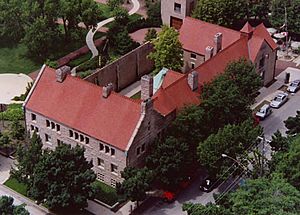List of Chicago Landmarks facts for kids


A Chicago Landmark is a special place in Chicago, Illinois, chosen by the city's Mayor and City Council of Chicago. These landmarks are historic sites that are important for many reasons, like their history, architecture, art, culture, or how they helped the city grow. Once a place becomes a landmark, it is protected by city rules. This means that if anyone wants to change it, even for simple repairs or to tear it down, they need permission from the Landmarks Commission. Many Chicago Landmarks are also listed on the National Register of Historic Places, which helps protect them even more and can provide money for their care. Some are even called National Historic Landmarks, which gives them extra national protection.
What Makes a Place a Landmark?
The Mayor and City Council choose nine people to be on the Commission on Chicago Landmarks. This group suggests places to become landmarks. They follow rules from a city law made in 1968. A place can become a landmark if it meets at least two of these important rules:
- It shows Chicago's heritage: The place is a great example of Chicago's history, culture, economy, or art. This can also apply to the State of Illinois or the United States.
- It was a site of a big event: A major historical event happened there. This event might or might not have used the buildings that are there now.
- It's linked to important people: The place is connected to someone who greatly helped Chicago, Illinois, or the U.S. in areas like architecture, culture, or history.
- It's a special type of building: The building shows a unique or rare style of architecture. It might be known for its new ideas, special details, or excellent design.
- It was built by a famous person: A well-known architect, designer, engineer, or builder created it. Their work is important to Chicago's history.
- It represents a theme: The place is part of a larger story or theme in Chicago's history. This could be seen through a group of buildings or an entire area.
- It's a familiar sight: The place has a special look or location that makes it a well-known part of a neighborhood, community, or the city.
If the commission decides a place meets at least two of these rules, they can give it a first approval. This means the place has important historical, community, architectural, or artistic value, and its original look is still strong.
History of Protecting Chicago's Past
At first, people in Chicago who wanted to save old buildings only focused on single, very important ones. But over time, this idea grew to include whole neighborhoods and even natural areas. Now, protecting old places is a key part of how the city plans and designs its future.
Three main things led to people wanting to formally protect Chicago's history:
- City changes: The government started "urban renewal" projects, which sometimes destroyed homes and neighborhoods.
- New roads: Fast highways were built, often cutting through neighborhoods and changing them forever.
- Building boom: There was a huge demand for new office buildings in the Loop area, leading to many older buildings being torn down.
In 1957, Leon Despres, a city leader, started the landmark movement in Chicago. He helped save the Frank Lloyd Wright Robie House. This led to the creation of the City Landmarks Commission, which first chose 39 buildings as "honorary" landmarks. This group later became the current Commission on Chicago Landmarks. In 1968, a new city law gave them the power to officially choose and protect 12 important buildings as the first Chicago Landmarks. Even though some famous buildings, like [[

